Adaptive Indoor Area Localization for Perpetual Crowdsourced Data Collection
Abstract
1. Introduction
- We introduce the concept of adaptive area localization to enable area classification for crowdsourced data that are continuously generated.
- We propose the idea of data-aware floor plan segmentation to compute segmentations that benefit subsequent classification. We present a clustering-based algorithm that determines such a segmentation with adjustable granularity.
- We formulate a metric to compare various area classifiers, such that the model, providing the optimal balance between expressiveness and performance, can be selected. This allows for automatic model building and selection in the setting of continuous crowdsourced data collection.
- We provide a comprehensive experimental study to validate the concepts on a self-generated and a publicly available crowdsourced data set.
2. Related Work
2.1. Crowdsourcing
- Inaccurate position tags for crowdsourced fingerprints that might occur during manual labeling of non-experts or are caused by automatic labeling via probabilistic models.
- The fluctuating dimensionality of RSS signals caused by varying numbers of hearable access points for various locations.
- The device heterogeneity that causes RSS to differ across various devices for the same measurement position.
- The nonuniform spatial data distribution, meaning that some areas feature a larger amount of data, while for others no data was collected.
2.2. Area Localization
2.3. Deep Learning for Fingerprinting
3. Adaptive Area Classification for Crowdsourced Data
3.1. Concept Overview
- The expressiveness measures the information gain of the user, which is mainly influenced by the extent of each individual area and the total coverage of the model.
- The performance indicates how reliably the model predicts a certain area.
3.2. Data Notations
3.3. Floor Plan Segmentation for Area Classification
3.4. ML Models for Area Classification
3.5. Area Classification Score
4. Floor Plan Segmentation Algorithms
Locally Dense Cluster Expansion (LDCE)
| Algorithm 1 LDCE floor plan segmentation | |
| 1: Inputs: | |
| Fingerprints: | ▹ |
| Walls: | ▹ |
| Main parameters: | |
| Distance penalties: | |
| DBSCAN parameters: | |
| Postprocessing: | |
| 2: Initialize: | |
| ▹ | |
| ▹ Main routine | |
| 3: while and do | |
| 4: | ▹ |
| 5: | |
| 6: | |
| 7: | |
| 8: | |
| 9: if then | |
| 10: | |
| 11: else | |
| 12: | |
| 13: end if | |
| 14: end while | |
| ▹ Postprocessing | |
| 15: for all C in do | |
| 16: if then | |
| 17: | |
| 18: | |
| 19: end if | |
| 20: end for | |
| 21: for all C in do | |
| 22: Add C to closest if closer than | |
| 23: end for | |
| ▹ Determine final shapes | |
| 24: | ▹ |
| 25: | |
| 26: return A | |
5. Machine Learning Model Building
5.1. Preprocessing
5.1.1. Feature Preprocessing
5.1.2. Floor Plan Segmentation (Parameter Choice)
5.1.3. Label Preprocessing
5.2. Model Training
5.3. Model Evaluation
- Area classifiers: The training data is labeled according to the computed floor plan segmentations. We apply k-fold cross validation with k=5, such that we arrive at 20% test data per fold. We utilize the stratified version to obtain a good representative of the whole data set in each split.
- Regression models: We choose a subset of testing positions by applying DBSCAN on the position labels only. Based on the resulting clusters we apply 5-fold cross validation, such that 20% of the clusters are used as testing data in each fold.
- Area classifiers: The error vector consists of the pairwise distances between the centers of the predicted areas and the ground truth areas, which is zero in case of a correct prediction. The y-intercept of the CDF corresponds to the machine learning accuracy metric (ACC). The curve yields additional knowledge about the significance of misclassification. Furthermore, we report the score (F1).
- Regression models: In case of exact position estimation, the error vector consists of the pairwise distances between predictions and ground truth positions.
- Selection via ACS: During model selection, we utilize the ACS as metric. This requires computing the class-wise scores of the predicted and ground truth areas.
6. Experimental Evaluation
- Does adaptive area localization based on a data-aware floor plan segmentation provide more robust results than the standard regression approach for exact position estimation? In particular, is it suited for arbitrarily collected training data via crowdsourcing?
- When crowdsourced training data is generated continuously, the area classifier has to adapt to the current data basis. This is accomplished by recomputing the underlying floor plan segmentation and retraining a classification model on the data labeled with the corresponding areas. In this setting, is the proposed ACS suited for automatic model selection among a pool of models that provide varying performances and expressivenesses?
6.1. Study Design
- Static performance analysis (Section 6.2.1 and Section 6.3.1): we compute two floor plan segmentations with varying granularities for a snapshot of collected training data. For each segmentation we train and evaluate various classification models. In addition, the performance of the proposed area classifiers is compared to standard regression models that aim at pinpointing the exact location.
- Model selection via ACS for continuous data collection (Section 6.2.2 and Section 6.3.2): we subdivide all available training data into 5 epochs that contain roughly the same amount of additional data to simulate the continuous data collection. For each epoch we compute a pool of floor plan segmentations, where we choose the parameters and empirically to obtain segmentations with various granularities. Subsequently, we optimize a classifier on the data labeled with the areas. The parameter has to be chosen according to the use case requirements. We exemplarily choose the outer bounds (0 and 1), where 0 provides high performance and low expressiveness and 1 targets models with higher expressiveness. Furthermore, is chosen to select a balanced model. We demonstrate how to utilize the ACS to automatically select the optimal model for the given use case requirements.
6.2. Case Study: RWTH Aachen University Building
6.2.1. Static Performance Analysis
6.2.2. Model Selection via ACS
6.3. Case Study: Tampere, Finland
6.3.1. Static Performance Analysis
6.3.2. Model Selection via ACS
7. Discussion
7.1. Case Study Results
7.2. Adaptive Area Localization
- It is determined independent of the available training data.
- It is statically determined, mostly prior to data collection.
7.3. Potential Applications
8. Conclusions
Author Contributions
Funding
Conflicts of Interest
References
- Zafari, F.; Gkelias, A.; Leung, K.K. A Survey of Indoor Localization Systems and Technologies. Commun. Surv. Tutorials IEEE 2019, 21, 2568–2599. [Google Scholar] [CrossRef]
- Basiri, A.; Lohan, E.S.; Moore, T.; Winstanley, A.; Peltola, P.; Hill, C.; Amirian, P.; Figueiredo e Silva, P. Indoor location based services challenges, requirements and usability of current solutions. Comput. Sci. Rev. 2017, 24, 1–12. [Google Scholar] [CrossRef]
- Wang, Y.; Shao, L. Understanding occupancy pattern and improving building energy efficiency through Wi-Fi based indoor positioning. Build. Environ. 2017, 114, 106–117. [Google Scholar] [CrossRef]
- D’Aloia, M.; Cortone, F.; Cice, G.; Russo, R.; Rizzi, M.; Longo, A. Improving energy efficiency in building system using a novel people localization system. In Proceedings of the 2016 IEEE Workshop on Environmental, Energy, and Structural Monitoring Systems (EESMS), Bari, Italy, 13–14 June 2016; pp. 1–6. [Google Scholar] [CrossRef]
- Ahmetovic, D.; Murata, M.; Gleason, C.; Brady, E.; Takagi, H.; Kitani, K.; Asakawa, C. Achieving Practical and Accurate Indoor Navigation for People with Visual Impairments. In Proceedings of the 14th Web for All Conference on The Future of Accessible Work—W4A ’17; ACM Press: New York, NY, USA, 2017; pp. 1–10. [Google Scholar] [CrossRef]
- Ho, T.W.; Tsai, C.J.; Hsu, C.C.; Chang, Y.T.; Lai, F. Indoor navigation and physician-patient communication in emergency department. In Proceedings of the 3rd International Conference on Communication and Information Processing—ICCIP ’17; Ben-Othman, J., Gang, F., Liu, J.S., Arai, M., Eds.; ACM Press: New York, NY, USA, 2017; pp. 92–98. [Google Scholar] [CrossRef]
- Kárník, J.; Streit, J. Summary of available indoor location techniques. IFAC-PapersOnLine 2016, 49, 311–317. [Google Scholar] [CrossRef]
- He, S.; Chan, S.H.G. Wi-Fi Fingerprint-Based Indoor Positioning: Recent Advances and Comparisons. Commun. Surv. Tutorials IEEE 2016, 18, 466–490. [Google Scholar] [CrossRef]
- Xia, S.; Liu, Y.; Yuan, G.; Zhu, M.; Wang, Z. Indoor Fingerprint Positioning Based on Wi-Fi: An Overview. ISPRS Int. J. Geo-Inf. 2017, 6, 135. [Google Scholar] [CrossRef]
- Batistic, L.; Tomic, M. Overview of indoor positioning system technologies. In Proceedings of the 2018 41st International Convention on Information and Communication Technology, Electronics and Microelectronics (MIPRO), Opatija, Croatia, 21–25 May 2018; pp. 473–478. [Google Scholar] [CrossRef]
- Yassin, A.; Nasser, Y.; Awad, M.; Al-Dubai, A.; Liu, R.; Yuen, C.; Raulefs, R.; Aboutanios, E. Recent Advances in Indoor Localization: A Survey on Theoretical Approaches and Applications. Commun. Surv. Tutorials IEEE 2017, 19, 1327–1346. [Google Scholar] [CrossRef]
- Rai, A.; Chintalapudi, K.K.; Padmanabhan, V.N.; Sen, R. Zee: Zero-Effort Crowdsourcing for Indoor Localization. In Proceedings of the 18th Annual International Conference on Mobile Computing and Networking (Mobicom ’12), Istanbul, Turkey, 22–26 August 2012; pp. 293–304. [Google Scholar]
- Radu, V.; Marina, M.K. HiMLoc: Indoor smartphone localization via activity aware Pedestrian Dead Reckoning with selective crowdsourced WiFi fingerprinting. In Proceedings of the International Conference on Indoor Positioning and Indoor Navigation, Montbeliard-Belfort, France, 28–31 October 2013; pp. 1–10. [Google Scholar] [CrossRef]
- Santos, R.; Barandas, M.; Leonardo, R.; Gamboa, H. Fingerprints and Floor Plans Construction for Indoor Localisation Based on Crowdsourcing. Sensors 2019, 19, 919. [Google Scholar] [CrossRef]
- Ye, Y.; Wang, B. RMapCS: Radio Map Construction From Crowdsourced Samples for Indoor Localization. IEEE Access 2018, 6, 24224–24238. [Google Scholar] [CrossRef]
- He, S.; Tan, J.; Chan, S.H.G. Towards area classification for large-scale fingerprint-based system. In Proceedings of the 2016 ACM International Joint Conference on Pervasive and Ubiquitous Computing - UbiComp ’16; Lukowicz, P., Krüger, A., Bulling, A., Lim, Y.K., Patel, S.N., Eds.; ACM Press: New York, NY, USA, 2016; pp. 232–243. [Google Scholar] [CrossRef]
- Lopez-Pastor, J.A.; Ruiz-Ruiz, A.J.; Martinez-Sala, A.S.; Luis Gomez-Tornero, J. Evaluation of an indoor positioning system for added-value services in a mall. In Proceedings of the 2019 International Conference on Indoor Positioning and Indoor Navigation (IPIN), Pisa, Italy, 30 September 2019–3 October 2019; pp. 1–8. [Google Scholar] [CrossRef]
- Wei, J.; Zhou, X.; Zhao, F.; Luo, H.; Ye, L. Zero-cost and map-free shop-level localization algorithm based on crowdsourcing fingerprints. In Proceedings of the 2018 Ubiquitous Positioning, Indoor Navigation and Location-Based Services (UPINLBS), Wuhan, China, 22–23 March 2018; pp. 1–10. [Google Scholar] [CrossRef]
- Rezgui, Y.; Pei, L.; Chen, X.; Wen, F.; Han, C. An Efficient Normalized Rank Based SVM for Room Level Indoor WiFi Localization with Diverse Devices. Mob. Inf. Syst. 2017, 2017, 1–19. [Google Scholar] [CrossRef]
- Liu, H.X.; Chen, B.A.; Tseng, P.H.; Feng, K.T.; Wang, T.S. Map-Aware Indoor Area Estimation with Shortest Path Based on RSS Fingerprinting. In Proceedings of the 2015 IEEE 81st Vehicular Technology Conference (VTC Spring), Glasgow, UK, 11–14 May 2015; pp. 1–5. [Google Scholar] [CrossRef]
- Torres-Solis, J.; Falk, T.; Chau, T. A Review of Indoor Localization Technologies: Towards Navigational Assistance for Topographical Disorientation. In Ambient Intelligence; Villanueva Molina, F.J., Ed.; IntechOpen: Rijeka, Croatia, 2010. [Google Scholar] [CrossRef]
- Pecoraro, G.; Di Domenico, S.; Cianca, E.; de Sanctis, M. LTE signal fingerprinting localization based on CSI. In Proceedings of the 2017 IEEE 13th International Conference on Wireless and Mobile Computing, Networking and Communications (WiMob), Rome, Italy, 9–11 October 2017; pp. 1–8. [Google Scholar] [CrossRef]
- Xiao, L.; Behboodi, A.; Mathar, R. A deep learning approach to fingerprinting indoor localization solutions. In Proceedings of the 2017 27th International Telecommunication Networks and Applications Conference (ITNAC), Melbourne, VIC, Australia, 22–24 November 2017; pp. 1–7. [Google Scholar] [CrossRef]
- Sinha, R.S.; Lee, S.M.; Rim, M.; Hwang, S.H. Data Augmentation Schemes for Deep Learning in an Indoor Positioning Application. Electronics 2019, 8, 554. [Google Scholar] [CrossRef]
- Yang, S.; Dessai, P.; Verma, M.; Gerla, M. FreeLoc: Calibration-free crowdsourced indoor localization. In Proceedings of the 2013 Proceedings IEEE INFOCOM, Turin, Italy, 14–19 April 2013; pp. 2481–2489. [Google Scholar] [CrossRef]
- Kim, W.; Yang, S.; Gerla, M.; Lee, E.K. Crowdsource Based Indoor Localization by Uncalibrated Heterogeneous Wi-Fi Devices. Mob. Inf. Syst. 2016, 2016, 1–18. [Google Scholar] [CrossRef]
- Mittal, A.; Tiku, S.; Pasricha, S. Adapting Convolutional Neural Networks for Indoor Localization with Smart Mobile Devices. In Proceedings of the 2018 on Great Lakes Symposium on VLSI—GLSVLSI ’18; Chen, D., Homayoun, H., Taskin, B., Eds.; ACM Press: New York, NY, USA, 2018; pp. 117–122. [Google Scholar] [CrossRef]
- Adege, A.; Lin, H.P.; Tarekegn, G.; Jeng, S.S. Applying Deep Neural Network (DNN) for Robust Indoor Localization in Multi-Building Environment. Appl. Sci. 2018, 8, 1062. [Google Scholar] [CrossRef]
- Wang, X.; Gao, L.; Mao, S.; Pandey, S. DeepFi: Deep learning for indoor fingerprinting using channel state information. In Proceedings of the 2015 IEEE Wireless Communications and Networking Conference (WCNC), New Orleans, LA, USA, 9–12 March 2015; pp. 1666–1671. [Google Scholar] [CrossRef]
- Wang, X.; Gao, L.; Mao, S.; Pandey, S. CSI-based Fingerprinting for Indoor Localization: A Deep Learning Approach. IEEE Trans. Veh. Technol. 2016, 66, 763–776. [Google Scholar] [CrossRef]
- Chen, H.; Zhang, Y.; Li, W.; Tao, X.; Zhang, P. ConFi: Convolutional Neural Networks Based Indoor Wi-Fi Localization Using Channel State Information. IEEE Access 2017, 5, 18066–18074. [Google Scholar] [CrossRef]
- Yang, Z.; Zhou, Z.; Liu, Y. From RSSI to CSI. ACM Comput. Surv. (CSUR) 2013, 46, 1–32. [Google Scholar] [CrossRef]
- He, S.; Chan, S.H.G. Towards Crowdsourced Signal Map Construction via Implicit Interaction of IoT Devices. In Proceedings of the 2017 14th Annual IEEE International Conference on Sensing, Communication, and Networking (SECON), San Diego, CA, USA, 12–14 June 2017; pp. 1–9. [Google Scholar] [CrossRef]
- Zhou, B.; Li, Q.; Mao, Q.; Tu, W. A Robust Crowdsourcing-Based Indoor Localization System. Sensors 2017, 17, 864. [Google Scholar] [CrossRef]
- Jiang, Q.; Ma, Y.; Liu, K.; Dou, Z. A Probabilistic Radio Map Construction Scheme for Crowdsourcing-Based Fingerprinting Localization. IEEE Sensors J. 2016, 16, 3764–3774. [Google Scholar] [CrossRef]
- Jung, S.h.; Moon, B.c.; Han, D. Unsupervised Learning for Crowdsourced Indoor Localization in Wireless Networks. IEEE Trans. Mob. Comput. 2016, 15, 2892–2906. [Google Scholar] [CrossRef]
- Jung, S.h.; Han, D. Automated Construction and Maintenance of Wi-Fi Radio Maps for Crowdsourcing-Based Indoor Positioning Systems. IEEE Access 2018, 6, 1764–1777. [Google Scholar] [CrossRef]
- Pipelidis, G.; Tsiamitros, N.; Ustaoglu, E.; Kienzler, R.; Nurmi, P.; Flores, H.; Prehofer, C. Cross-Device Radio Map Generation via Crowdsourcing. In Proceedings of the 2019 International Conference on Indoor Positioning and Indoor Navigation (IPIN), Pisa, Italy, 30 September 2019–3 October 2019; pp. 1–8. [Google Scholar] [CrossRef]
- Chow, K.H.; He, S.; Tan, J.; Chan, S.H.G. Efficient Locality Classification for Indoor Fingerprint-Based Systems. IEEE Trans. Mob. Comput. 2019, 18, 290–304. [Google Scholar] [CrossRef]
- Nowicki, M.; Wietrzykowski, J. Low-Effort Place Recognition with WiFi Fingerprints Using Deep Learning. In Automation 2017, Advances in Intelligent Systems and Computing, Warsaw, Poland, 15–17 March 2017; Szewczyk, R., Zieliński, C., Kaliczyńska, M., Eds.; Springer International Publishing: Cham, Switzerland, 2017; Volume 550, pp. 575–584. [Google Scholar] [CrossRef]
- Kim, K.S.; Lee, S.; Huang, K. A scalable deep neural network architecture for multi-building and multi-floor indoor localization based on Wi-Fi fingerprinting. Big Data Anal. 2018, 3, 466. [Google Scholar] [CrossRef]
- Ibrahim, M.; Torki, M.; ElNainay, M. CNN based Indoor Localization using RSS Time-Series. In Proceedings of the 2018 IEEE Symposium on Computers and Communications (ISCC), Natal, Brazil, 25–28 June 2018; pp. 01044–01049. [Google Scholar] [CrossRef]
- Song, C.; Wang, J. WLAN Fingerprint Indoor Positioning Strategy Based on Implicit Crowdsourcing and Semi-Supervised Learning. ISPRS Int. J. Geo-Inf. 2017, 6, 356. [Google Scholar] [CrossRef]
- Bishop, C.M. Pattern Recognition and Machine Learning (Information Science and Statistics); Springer: Secaucus, NJ, USA, 2006. [Google Scholar]
- Dong, K.; Ling, Z.; Xia, X.; Ye, H.; Wu, W.; Yang, M. Dealing with Insufficient Location Fingerprints in Wi-Fi Based Indoor Location Fingerprinting. Wirel. Commun. Mob. Comput. 2017, 2017, 1–11. [Google Scholar] [CrossRef]
- Han, J.; Kamber, M.; Pei, J. Data Mining: Concepts and Techniques, online-ausg ed.; Morgan Kaufmann Series in Data Management Systems; Elsevier Science: Burlington, Vermont, 2011. [Google Scholar]
- Goodfellow, I.; Bengio, Y.; Courville, A. Deep Learning; MIT Press: Cambridge, MA, USA, 2016. [Google Scholar]
- Lohan, E.; Torres-Sospedra, J.; Leppäkoski, H.; Richter, P.; Peng, Z.; Huerta, J. Wi-Fi Crowdsourced Fingerprinting Dataset for Indoor Positioning. Data 2017, 2, 32. [Google Scholar] [CrossRef]
- Rawat, W.; Wang, Z. Deep Convolutional Neural Networks for Image Classification: A Comprehensive Review. Neural Comput. 2017, 29, 2352–2449. [Google Scholar] [CrossRef]
- Rana, S.P.; Prieto, J.; Dey, M.; Dudley, S.; Corchado, J.M. A Self Regulating and Crowdsourced Indoor Positioning System through Wi-Fi Fingerprinting for Multi Storey Building. Sensors 2018, 18, 3766. [Google Scholar] [CrossRef]
- Chang, Q.; van de Velde, S.; Wang, W.; Li, Q.; Hou, H.; Heidi, S. Wi-Fi Fingerprint Positioning Updated by Pedestrian Dead Reckoning for Mobile Phone Indoor Localization. In China Satellite Navigation Conference (CSNC) 2015 Proceedings: Volume III; Lecture Notes in Electrical Engineering; Sun, J., Liu, J., Fan, S., Lu, X., Eds.; Springer: Berlin/Heidelberg, Germany, 2015; Volume 342, pp. 729–739. [Google Scholar] [CrossRef]
- Zou, H.; Chen, Z.; Jiang, H.; Xie, L.; Spanos, C. Accurate indoor localization and tracking using mobile phone inertial sensors, WiFi and iBeacon. In Proceedings of the 2017 IEEE International Symposium on Inertial Sensors and Systems (INERTIAL), Kauai, HI, USA, 27–30 March 2017; pp. 1–4. [Google Scholar] [CrossRef]
- Jin, F.; Liu, K.; Zhang, H.; Feng, L.; Chen, C.; Wu, W. Towards Scalable Indoor Localization with Particle Filter and Wi-Fi Fingerprint. In Proceedings of the 2018 15th Annual IEEE International Conference on Sensing, Communication, and Networking (SECON), Hong Kong, China, 11–13 June 2018; pp. 1–2. [Google Scholar] [CrossRef]
- Wang, X.; Yu, Z.; Mao, S. DeepML: Deep LSTM for Indoor Localization with Smartphone Magnetic and Light Sensors. In Proceedings of the 2018 IEEE International Conference on Communications (ICC), Kansas City, MO, USA, 20–24 May 2018; pp. 1–6. [Google Scholar] [CrossRef]
- Zhang, W.; Sengupta, R.; Fodero, J.; Li, X. DeepPositioning: Intelligent Fusion of Pervasive Magnetic Field and WiFi Fingerprinting for Smartphone Indoor Localization via Deep Learning. In Proceedings of the 2017 16th IEEE International Conference on Machine Learning and Applications (ICMLA), Cancun, Mexico, 18–21 December 2017; pp. 7–13. [Google Scholar] [CrossRef]
- Kanaris, L.; Kokkinis, A.; Liotta, A.; Stavrou, S. Fusing Bluetooth Beacon Data with Wi-Fi Radiomaps for Improved Indoor Localization. Sensors 2017, 17, 812. [Google Scholar] [CrossRef]
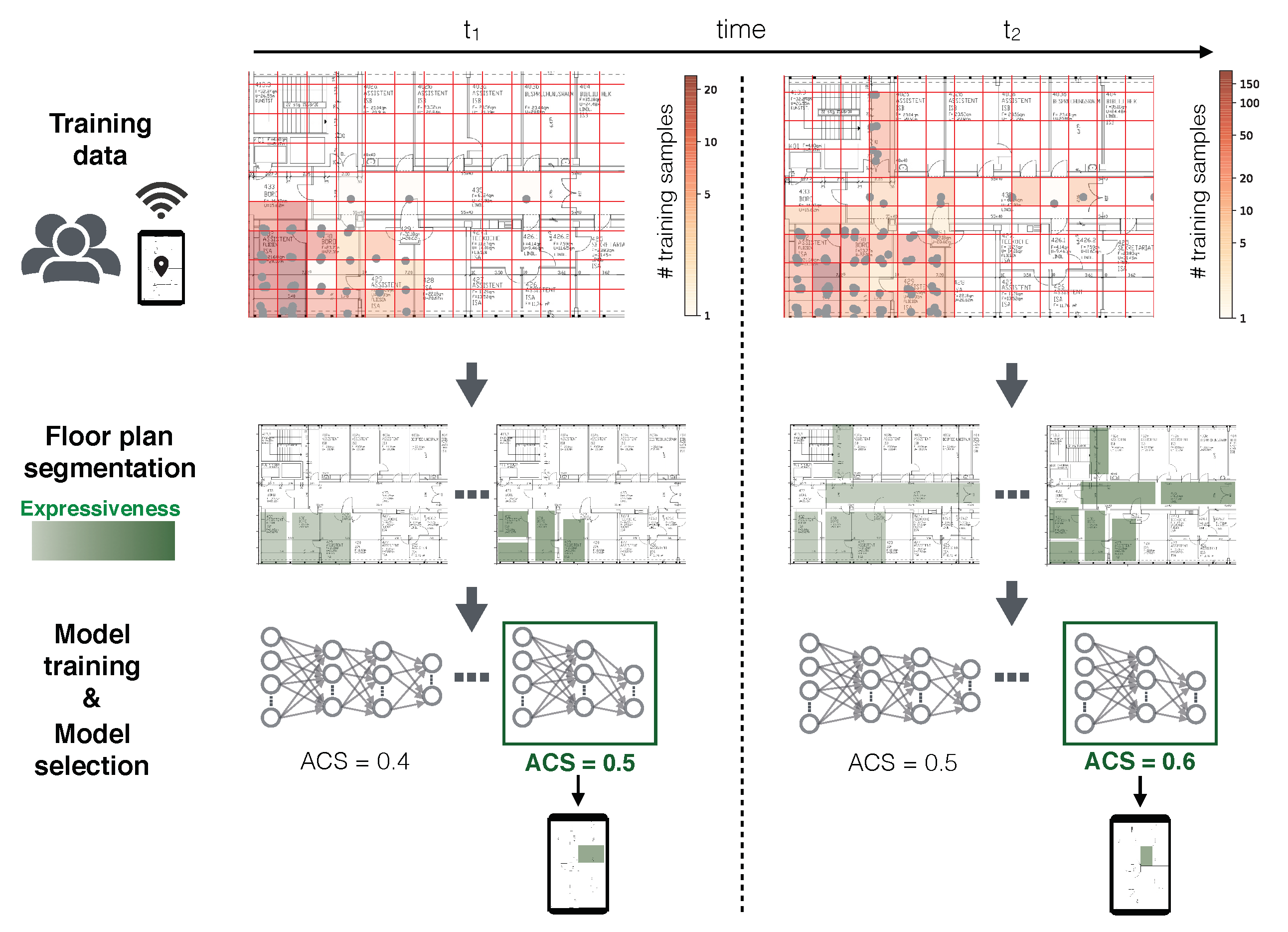
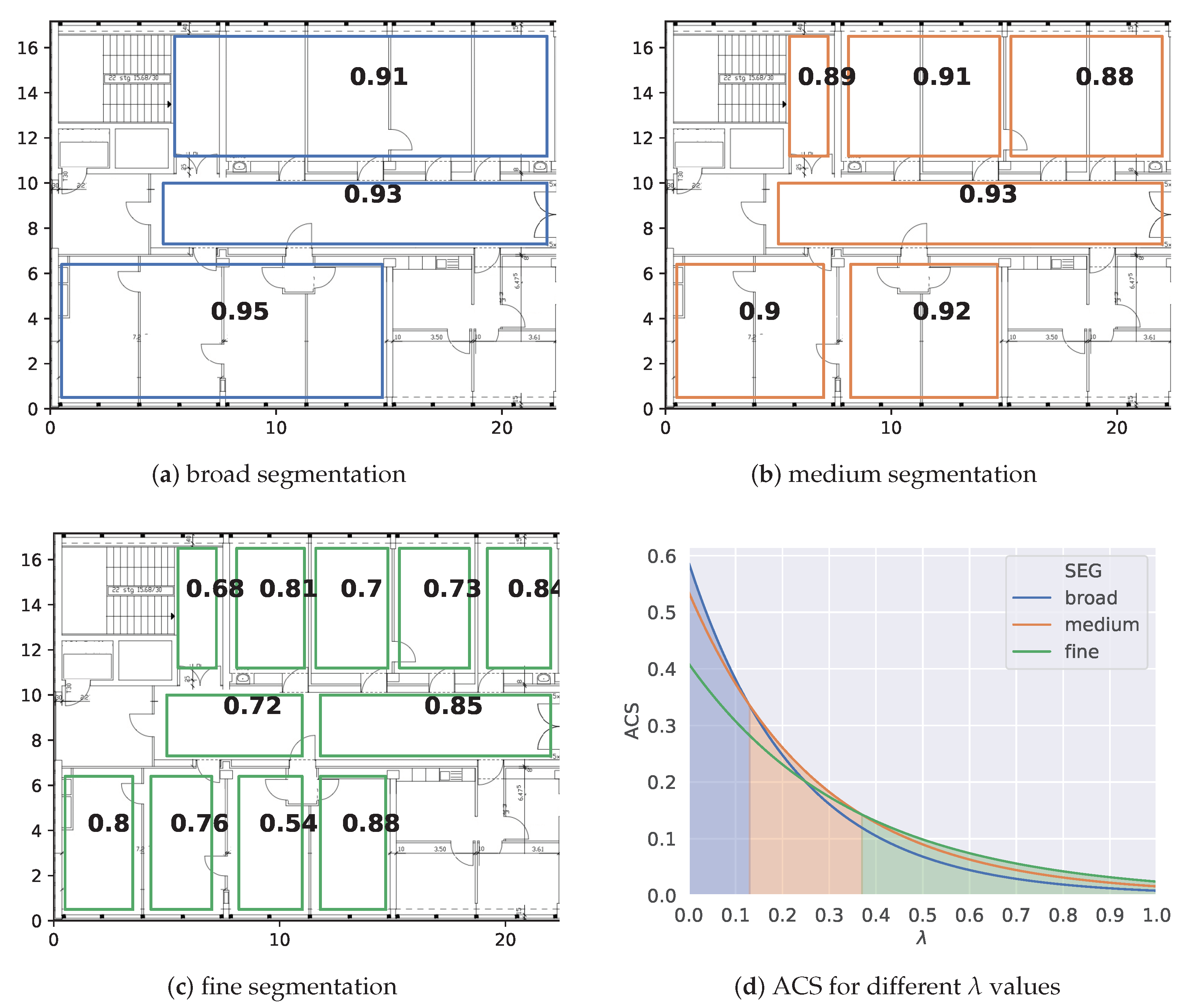
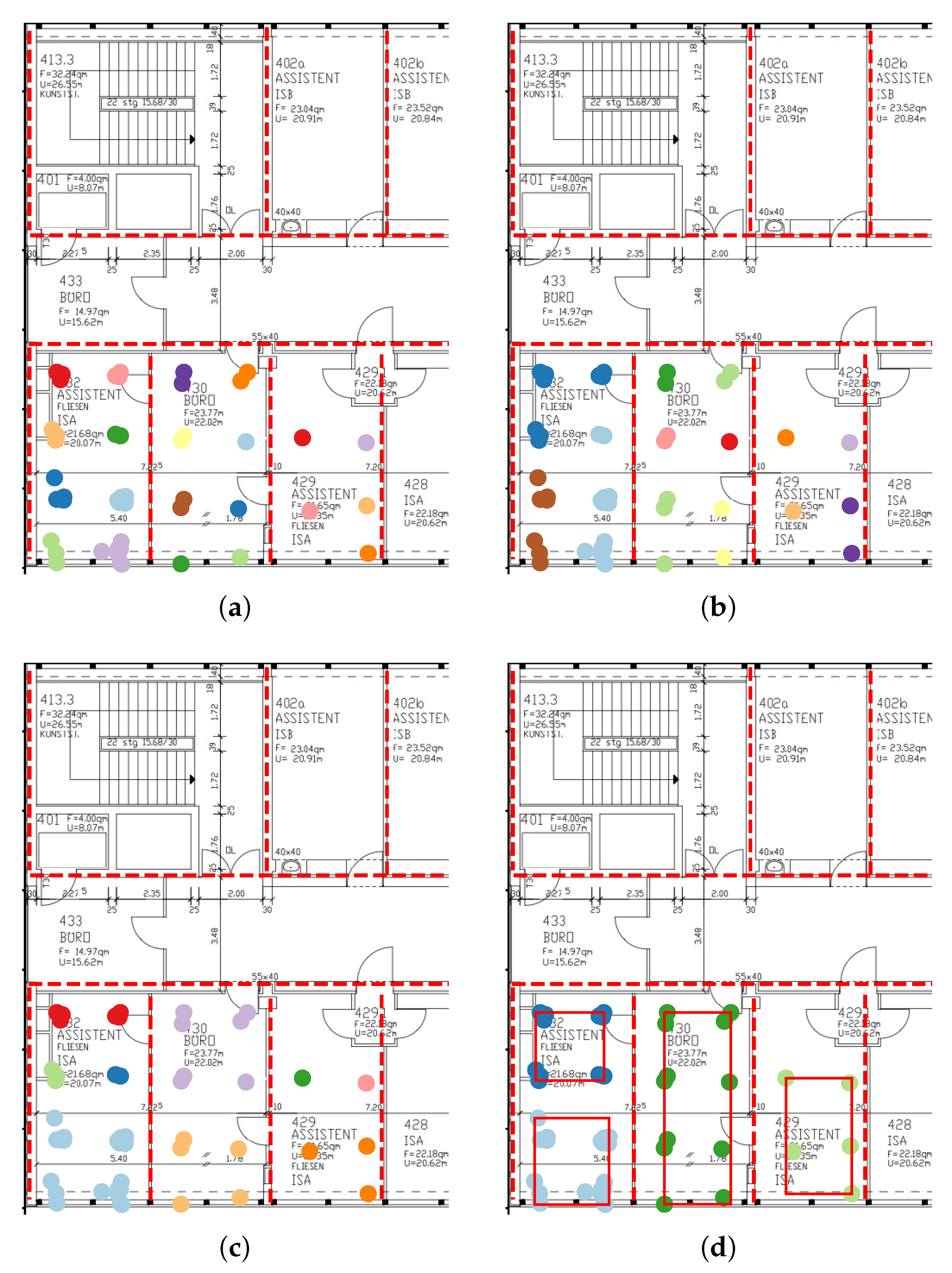
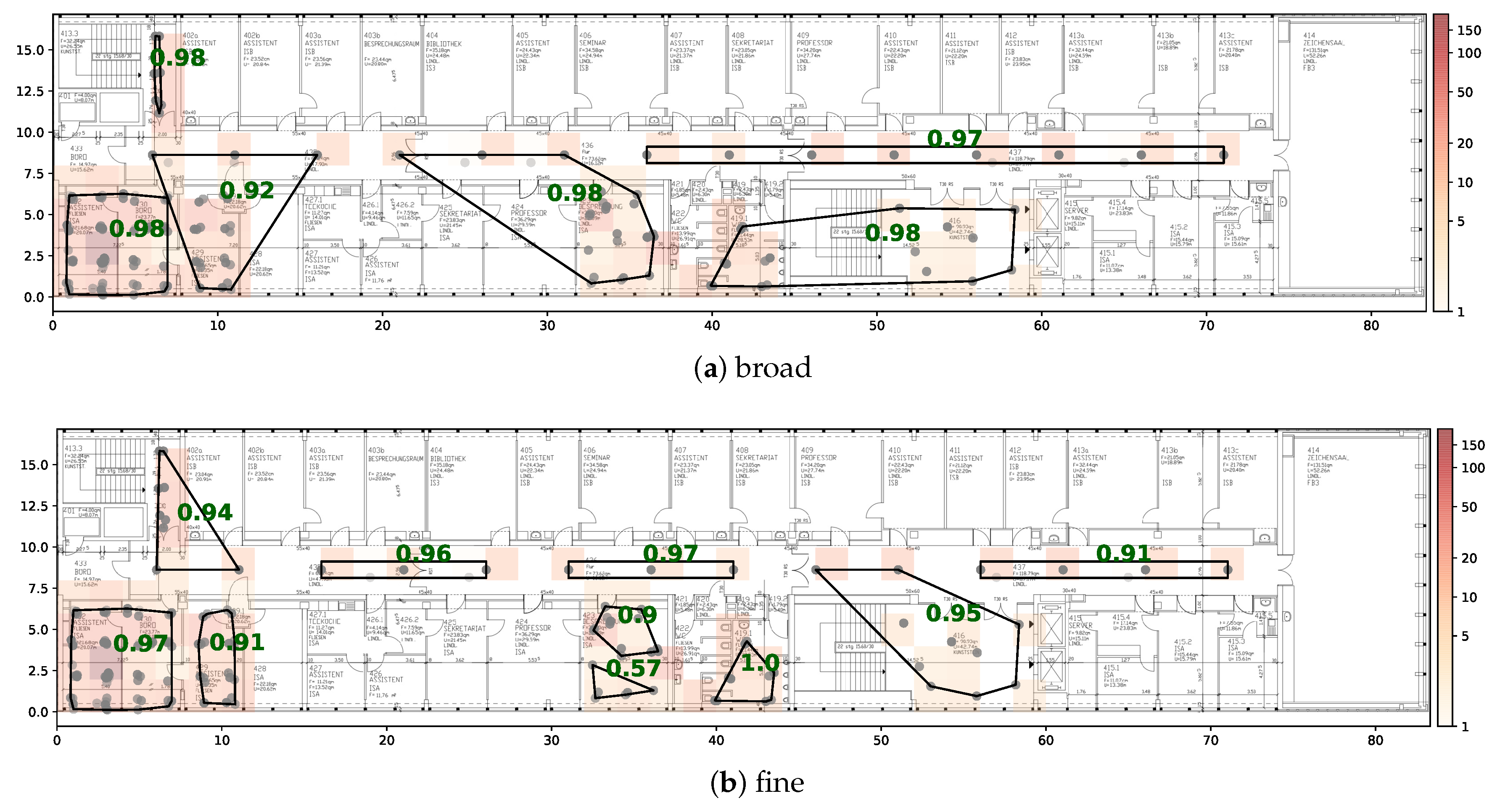
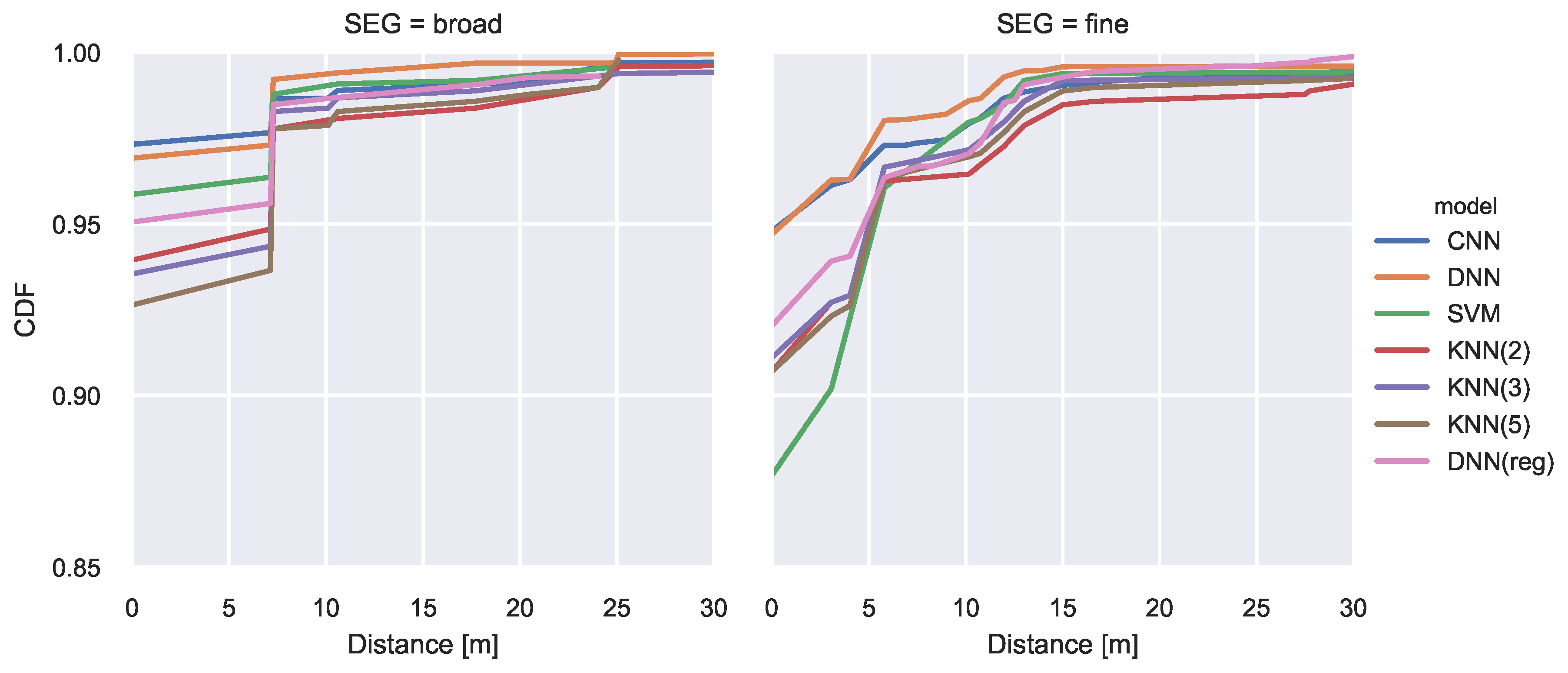


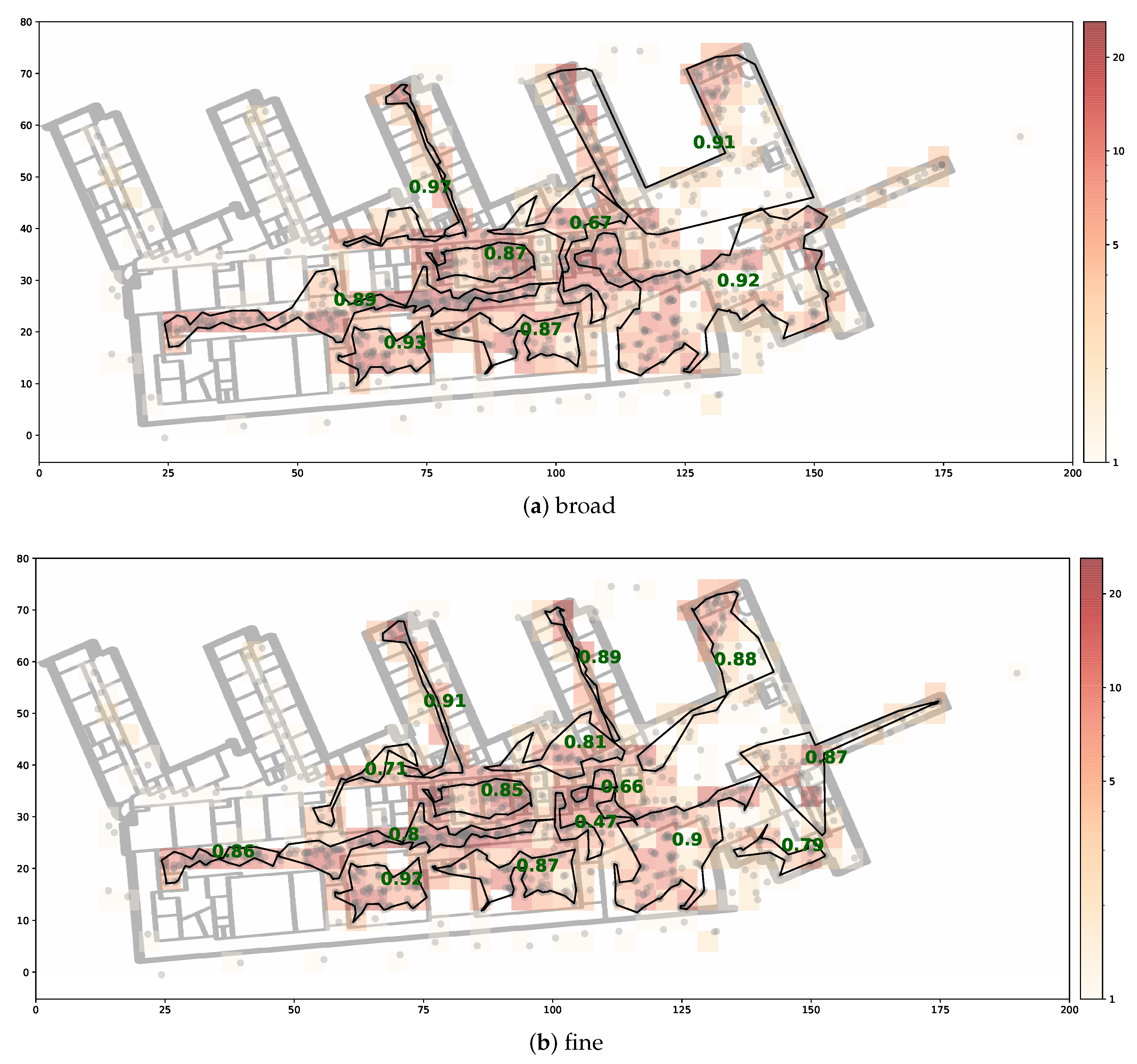
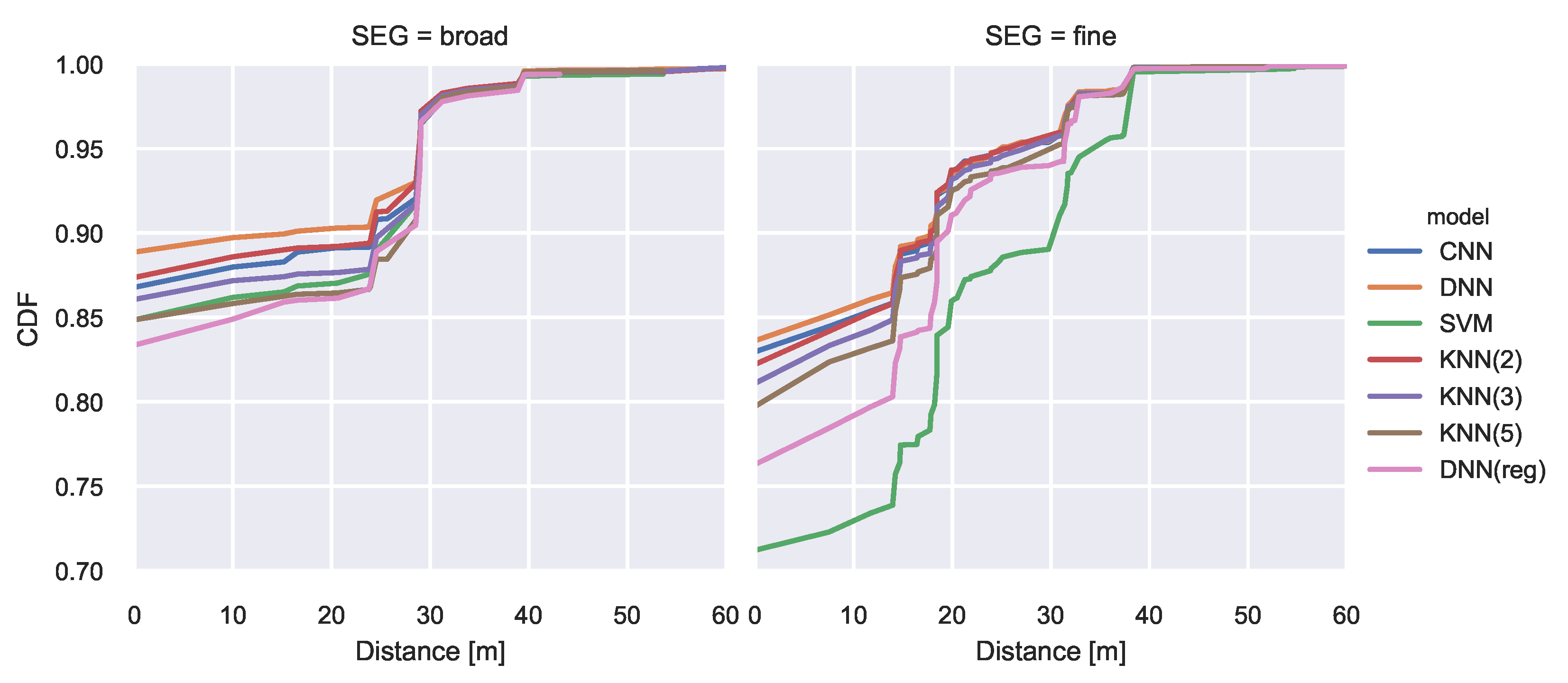


| Data Set | Main | Postprocessing | Penalties | DBSCAN | ||||
|---|---|---|---|---|---|---|---|---|
| stop_size | max_eps | minMembers | eps | minPts | ||||
| RWTH Aachen | {80, 50} | 30 | {40,20} | 10 | 2 | 20 | 2 | 3 |
| Tampere, Finnland | {100, 60} | 50 | {60, 40} | 5 | 2 | 20 | 5 | 3 |
| HU | HL | Dropout | Reg. Penalty | lr | Batch | Epochs | Loss | Activation | Optimizer |
|---|---|---|---|---|---|---|---|---|---|
| 512 | 3 | 0.2 | 0.06 | 0.0007 | 32 | 200 | Cat. cross-entropy | ReLU | Adam |
| Segmentation | Model | Parameter | Area Center Error | Classification | ||||
|---|---|---|---|---|---|---|---|---|
| Mean | Std | Min | Max | ACC | F1 | |||
| broad | CNN | 0.43 | 3.28 | 0.0 | 47.42 | 0.97 | 0.97 | |
| DNN | 0.32 | 2.17 | 0.0 | 47.42 | 0.97 | 0.97 | ||
| SVM | 0.54 | 3.46 | 0.0 | 45.25 | 0.96 | 0.95 | ||
| k-NN (reg- > class) | k = 2 | 0.85 | 4.36 | 0.0 | 49.95 | 0.94 | 0.93 | |
| k-NN (reg- > class) | k = 3 | 0.82 | 4.30 | 0.0 | 49.95 | 0.94 | 0.93 | |
| k-NN (reg- > class) | k = 5 | 0.87 | 3.94 | 0.0 | 49.95 | 0.93 | 0.92 | |
| DNN (reg- > class) | 0.56 | 2.88 | 0.0 | 25.09 | 0.95 | 0.95 | ||
| fine | CNN | 0.66 | 4.18 | 0.0 | 55.12 | 0.95 | 0.91 | |
| DNN | 0.54 | 3.74 | 0.0 | 59.90 | 0.95 | 0.91 | ||
| SVM | 1.12 | 4.80 | 0.0 | 59.90 | 0.88 | 0.79 | ||
| k-NN (reg- > class) | k = 2 | 1.15 | 5.47 | 0.0 | 59.90 | 0.91 | 0.84 | |
| k-NN (reg- > class) | k = 3 | 0.99 | 4.94 | 0.0 | 59.90 | 0.91 | 0.87 | |
| k-NN (reg- > class) | k = 5 | 1.00 | 4.54 | 0.0 | 48.34 | 0.91 | 0.86 | |
| DNN (reg- > class) | 0.71 | 3.07 | 0.0 | 42.50 | 0.92 | 0.87 | ||
| Segmentation | Model | Parameter | Area Center Error | Classification | ||||
|---|---|---|---|---|---|---|---|---|
| Mean | Std | Min | Max | ACC | F1 | |||
| broad | CNN | 3.70 | 10.15 | 0.0 | 69.26 | 0.87 | 0.86 | |
| DNN | 3.21 | 9.60 | 0.0 | 69.26 | 0.89 | 0.88 | ||
| SVM | 4.30 | 10.92 | 0.0 | 65.84 | 0.85 | 0.83 | ||
| k-NN (reg- > class) | k = 2 | 3.55 | 10.02 | 0.0 | 69.26 | 0.87 | 0.86 | |
| k-NN (reg- > class) | k = 3 | 3.97 | 10.48 | 0.0 | 69.26 | 0.86 | 0.85 | |
| k-NN (reg- > class) | k = 5 | 4.34 | 10.84 | 0.0 | 65.84 | 0.85 | 0.83 | |
| DNN (reg- > class) | 4.62 | 11.17 | 0.0 | 65.84 | 0.83 | 0.81 | ||
| fine | CNN | 3.65 | 9.11 | 0.0 | 90.47 | 0.83 | 0.81 | |
| DNN | 3.53 | 9.00 | 0.0 | 91.75 | 0.84 | 0.81 | ||
| SVM | 7.00 | 12.36 | 0.0 | 100.44 | 0.71 | 0.56 | ||
| k-NN (reg- > class) | k = 2 | 3.72 | 9.12 | 0.0 | 90.47 | 0.82 | 0.79 | |
| k-NN (reg- > class) | k = 3 | 3.95 | 9.30 | 0.0 | 90.47 | 0.81 | 0.77 | |
| k-NN (reg- > class) | k = 5 | 4.25 | 9.55 | 0.0 | 69.79 | 0.80 | 0.76 | |
| DNN(reg) | 5.00 | 10.07 | 0.0 | 69.79 | 0.76 | 0.72 | ||
© 2020 by the authors. Licensee MDPI, Basel, Switzerland. This article is an open access article distributed under the terms and conditions of the Creative Commons Attribution (CC BY) license (http://creativecommons.org/licenses/by/4.0/).
Share and Cite
Laska, M.; Blankenbach, J.; Klamma, R. Adaptive Indoor Area Localization for Perpetual Crowdsourced Data Collection. Sensors 2020, 20, 1443. https://doi.org/10.3390/s20051443
Laska M, Blankenbach J, Klamma R. Adaptive Indoor Area Localization for Perpetual Crowdsourced Data Collection. Sensors. 2020; 20(5):1443. https://doi.org/10.3390/s20051443
Chicago/Turabian StyleLaska, Marius, Jörg Blankenbach, and Ralf Klamma. 2020. "Adaptive Indoor Area Localization for Perpetual Crowdsourced Data Collection" Sensors 20, no. 5: 1443. https://doi.org/10.3390/s20051443
APA StyleLaska, M., Blankenbach, J., & Klamma, R. (2020). Adaptive Indoor Area Localization for Perpetual Crowdsourced Data Collection. Sensors, 20(5), 1443. https://doi.org/10.3390/s20051443





